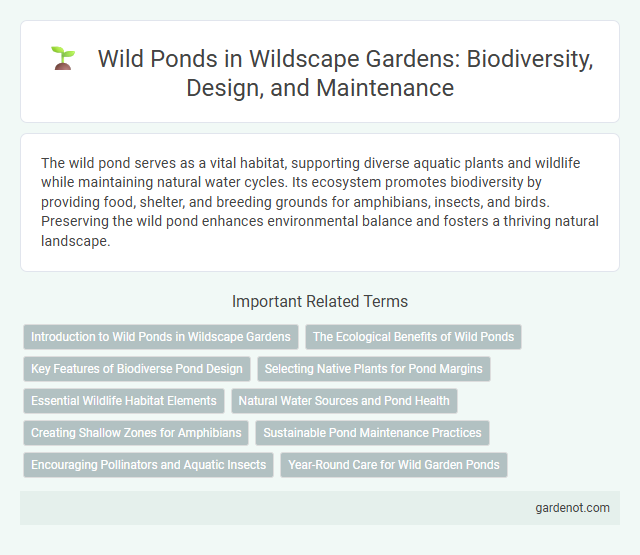The wild pond serves as a vital habitat, supporting diverse aquatic plants and wildlife while maintaining natural water cycles. Its ecosystem promotes biodiversity by providing food, shelter, and breeding grounds for amphibians, insects, and birds. Preserving the wild pond enhances environmental balance and fosters a thriving natural landscape.
Introduction to Wild Ponds in Wildscape Gardens
Wild ponds in Wildscape Gardens serve as vital ecosystems supporting diverse aquatic plants and wildlife, creating a balanced habitat that enhances biodiversity. These naturally designed water bodies facilitate water filtration, provide breeding grounds for amphibians, and attract pollinators such as dragonflies and bees. Integrating wild ponds into garden landscapes promotes ecological sustainability and enriches the overall environmental health of Wildscape Gardens.
The Ecological Benefits of Wild Ponds
Wild ponds serve as vital habitats, supporting diverse species such as amphibians, insects, and aquatic plants, which enhances local biodiversity. These ponds contribute to natural water filtration and help regulate water cycles by absorbing excess rainfall and recharging groundwater. The presence of wild ponds also promotes carbon sequestration through wetland vegetation, playing a significant role in mitigating climate change.
Key Features of Biodiverse Pond Design
Wildscape's wild pond design incorporates native aquatic plants and varied water depths to support diverse species, including amphibians, insects, and birds. The creation of shallow margins and submerged logs fosters habitats for breeding and shelter, enhancing ecological balance. Natural filtration through planted zones maintains water clarity and quality, promoting a self-sustaining ecosystem.
Selecting Native Plants for Pond Margins
Selecting native plants for wild pond margins enhances biodiversity by providing habitat and food sources for local wildlife, including amphibians, insects, and birds. Species such as water mint (Mentha aquatica), purple loosestrife (Lythrum salicaria), and soft rush (Juncus effusus) thrive in wet conditions while supporting pollinators and stabilizing soil. Incorporating native flora into pond edges ensures ecological balance, reduces maintenance needs, and promotes natural water filtration.
Essential Wildlife Habitat Elements
A wild pond provides critical essential wildlife habitat elements including clean water, native vegetation, and diverse aquatic invertebrates that support food webs. It offers shelter through submerged plants and logs, which serve as breeding grounds and refuge for amphibians, insects, and small fish. The pond's edge vegetation enhances biodiversity by creating transitional zones essential for many terrestrial and aquatic species.
Natural Water Sources and Pond Health
Wild ponds serve as critical natural water sources supporting diverse ecosystems in Wildscape areas. Maintaining pond health involves monitoring water quality parameters such as pH, dissolved oxygen, and nutrient levels to prevent eutrophication and sustain aquatic life. Native vegetation around wild ponds stabilizes banks, filters pollutants, and provides habitat, enhancing overall biodiversity and water clarity.
Creating Shallow Zones for Amphibians
Creating shallow zones in wild ponds enhances habitat suitability for amphibians by providing breeding grounds and protection from predators. These areas support diverse aquatic vegetation that offers food and shelter, crucial for amphibian larvae development. Implementing gradual slopes and maintaining water quality further promote amphibian population growth and biodiversity in wildscapes.
Sustainable Pond Maintenance Practices
Sustainable pond maintenance practices in Wildscape prioritize natural filtration systems using native aquatic plants to enhance water quality and support local biodiversity. Regular monitoring of pond pH, nutrient levels, and aquatic life ensures a balanced ecosystem while minimizing chemical use. Employing organic mulching and promoting habitat for beneficial insects further contribute to the pond's ecological resilience and long-term health.
Encouraging Pollinators and Aquatic Insects
Creating a wild pond in a Wildscape fosters habitats for essential pollinators such as bees, butterflies, and dragonflies, which rely on native aquatic plants for nectar and breeding grounds. The presence of diverse submerged and emergent vegetation supports aquatic insect populations like water beetles, damselflies, and caddisflies, crucial for maintaining balanced ecosystem dynamics. Promoting these habitats enhances biodiversity, aids in natural pest control, and contributes to the overall health and resilience of the surrounding environment.
Year-Round Care for Wild Garden Ponds
Wild garden ponds require year-round care to maintain ecological balance and support diverse wildlife throughout all seasons. Consistent monitoring of water quality, removal of debris, and management of aquatic plants encourage healthy habitats for amphibians, insects, and native birds. Preparing for winter involves preventing ice damage and ensuring oxygen levels remain stable to protect aquatic life.
Wild pond Infographic

 gardenot.com
gardenot.com